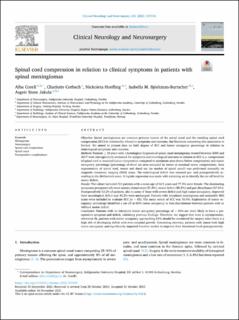| dc.contributor.author | Corell, Alba | |
| dc.contributor.author | Cerbach, Charlotte | |
| dc.contributor.author | Hoefling, Nickoleta | |
| dc.contributor.author | Björkman-Burtscher, Isabella M. | |
| dc.contributor.author | Jakola, Asgeir Store | |
| dc.date.accessioned | 2022-12-06T14:40:37Z | |
| dc.date.available | 2022-12-06T14:40:37Z | |
| dc.date.created | 2021-12-03T00:52:57Z | |
| dc.date.issued | 2021 | |
| dc.identifier.citation | Clinical neurology and neurosurgery (Dutch-Flemish ed. Print). 2021, 211 | en_US |
| dc.identifier.issn | 0303-8467 | |
| dc.identifier.uri | https://hdl.handle.net/11250/3036181 | |
| dc.description.abstract | Objective: Spinal meningiomas are common primary tumors of the spinal canal and the resulting spinal cord compression (SCC) is intrinsically related to symptoms and outcome, but literature concerning this association is limited. We aimed to present data on both degree of SCC and tumor occupancy percentage in relation to neurological symptoms and outcome.
Methods: Patients ≥ 18 years with a histological diagnosis of spinal canal meningioma treated between 2000 and 2017 were retrospectively evaluated for symptoms and neurological outcome in relation to SCC (i.e. compression of spinal cord at maximal tumor compression compared to maximum area above/below compression) and tumor occupancy percentage (percentage of dural sac area occupied by tumor at maximal tumor compression). Area segmentation of spinal cord, tumor and dural sac (as marker of spinal canal) was performed manually on magnetic resonance imaging (MRI) scans. The neurological deficit was assessed pre- and postoperatively according to the McCormick score. A logistic regression was made with a training set to identify the cut-off level for motor deficit.
Results: The cohort included 111 patients with a mean age of 62.5 years and 77.5% were female. The dominating symptoms preoperatively were sensory disturbance (91.0%), motor deficit (80.2%) and gait disturbance (67.6%). Postoperatively 53.2% of patients, also in some of those with severe deficit and high tumor occupancy, improved their neurological deficit and 43.2% were unchanged. Patients with intradural meningioma and assessable MRI scans were included to evaluate SCC (n = 83). The mean extent of SCC was 50.6%. Exploration of tumor occupancy percentage identified a cut-off at 65% tumor occupancy to best discriminate between patients with or without motor deficit.
Conclusion: Patients with an intradural tumor occupancy percentage of > 65% are more likely to have a preoperative symptom and deficit, validating previous findings. Therefore, we suggest that even in asymptomatic, otherwise fit, patients with tumor occupancy approaching 65% should be considered for surgery since there is a high risk of developing deficit with even minimal growth. Concerning recovery, patients with tumor both high tumor occupancy and significantly impaired function tended to improve their functional level postoperatively. | en_US |
| dc.language.iso | eng | en_US |
| dc.publisher | Elsevier | en_US |
| dc.rights | Navngivelse 4.0 Internasjonal | * |
| dc.rights.uri | http://creativecommons.org/licenses/by/4.0/deed.no | * |
| dc.title | Spinal cord compression in relation to clinical symptoms in patients with spinal meningiomas | en_US |
| dc.type | Peer reviewed | en_US |
| dc.type | Journal article | en_US |
| dc.description.version | publishedVersion | en_US |
| dc.source.volume | 211 | en_US |
| dc.source.journal | Clinical neurology and neurosurgery (Dutch-Flemish ed. Print) | en_US |
| dc.identifier.doi | 10.1016/j.clineuro.2021.107018 | |
| dc.identifier.cristin | 1963905 | |
| cristin.ispublished | true | |
| cristin.fulltext | original | |
| cristin.qualitycode | 1 | |

